
Eggplant, aubergine or brinjal is a plant species in the nightshade family Solanaceae. Solanum melongena is grown worldwide for its edible fruit.
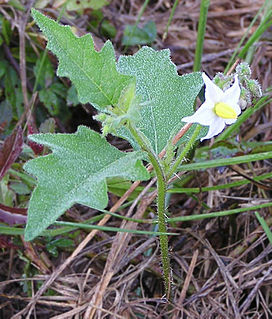
Solanum carolinense, the Carolina horsenettle, is not a true nettle, but a member of the Solanaceae, or nightshade family. It is a perennial herbaceous plant, native to the southeastern United States that has spread widely throughout much of temperate North America. It has also been found in parts of Europe, Asia, and Australia. The stem and undersides of larger leaf veins are covered with spines.

Solanum dulcamara is a species of vine in the potato genus Solanum, family Solanaceae. Common names include bittersweet, bittersweet nightshade, bitter nightshade, blue bindweed, Amara Dulcis, climbing nightshade, fellenwort, felonwood, poisonberry, poisonflower, scarlet berry, snakeberry, trailing bittersweet, trailing nightshade, violet bloom, and woody nightshade.

Solanum mauritianum is a small tree or shrub native to South America, including Northern Argentina, Southern Brazil, Paraguay and Uruguay. It has become a widespread invasive weed in Azores Islands, Cook Islands, Fiji, Hawai‘i, New Caledonia, Norfolk Island, Solomon Islands, Tonga, Réunion Island, Mauritius, Madagascar, Australia, New Zealand, India, Sri Lanka and several southern African countries. Its common names include earleaf nightshade, woolly nightshade, flannel weed, bugweed, tobacco weed, tobacco bush, wild tobacco and kerosene plant.
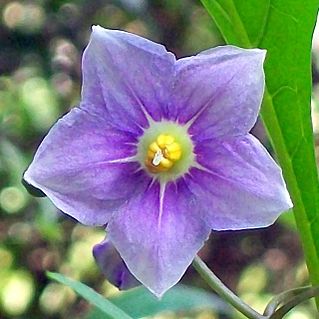
Solanum aviculare, commonly called poroporo, kangaroo apple, pam plum (Australia), or New Zealand nightshade, is a soft-wooded shrub native to New Zealand and the east coast of Australia.

Solanum centrale, the kutjera, or Australian desert raisin, is a plant native to the more arid parts of Australia. Like other "bush tomatoes", it has been used as a food source by Central Australia and Aboriginal groups for millennia.

Solanum nigrum, the European black nightshade or simply black nightshade or blackberry nightshade, is a species of flowering plant in the genus Solanum, native to Eurasia and introduced in the Americas, Australasia, and South Africa. Ripe berries and cooked leaves of edible strains are used as food in some locales, and plant parts are used as a traditional medicine. A tendency exists in literature to incorrectly refer to many of the other "black nightshade" species as "Solanum nigrum".
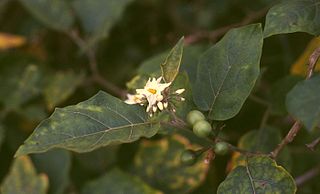
Solanum torvum, the turkey berry, devil's fig, pea eggplant, platebrush or susumber, is a bushy, erect and spiny perennial plant used horticulturally as a rootstock for eggplant. Grafted plants are very vigorous and tolerate diseases affecting the root system, thus allowing the crop to continue for a second year.

Solanum elaeagnifolium, the silverleaf nightshade or silver-leaved nightshade, is a common native plant to parts of the sw USA, and sometimes weed of western North America and also found in South America. Other common names include prairie berry, silverleaf nettle, white horsenettle or silver nightshade. In South Africa it is known as silver-leaf bitter-apple or satansbos. More ambiguous names include "bull-nettle", "horsenettle" and the Spanish "trompillo". The plant is also endemic to the Middle East.

Solanum prinophyllum, known as the forest nightshade, is a small plant native to the east coast of Australia. It is a short lived herb, annual or perennial.

Solanum erianthum is a species of nightshade that is native to southern North America and northern South America. It has been introduced to other parts of the world and has a nearly pantropical distribution. Common names include potatotree, mullein nightshade, velvet nightshade, and salvadora. The potatoes are not the fruits of the trees, they are the leaves.
Solanum vescum, commonly known as green kangaroo apple or gunyang, is a small fruiting shrub in the family Solanaceae, native to eastern and southeastern Australia.

Solanum pungetium, known as the eastern nightshade is a small, low spreading plant native to the east coast of Australia.

Solanum tampicense, also known as wetland nightshade, aquatic soda apple, and scrambling nightshade, is a perennial in the Solanaceae or Nightshade Family. It can exist as a vine, tree, or shrub and is native to the West Indies and Central America. It is classified as a noxious weed by the United States Department of Agriculture and by several states and is known as an invasive species in the state of Florida.

Persoonia muelleri, commonly known as Mueller’s geebung, is a shrub endemic to Tasmania. It forms a shrub in open areas of wet forests in the west and northeast of the state. It is occasionally confused with P. gunnii though it has larger flowers and longer, straighter leaves.

Solanum macrocarpon otherwise known as the African eggplant or Vietnamese eggplant is a plant of the family Solanaceae. S. macrocarpon is a tropical perennial plant that is closely related to the eggplant. S. macrocarpon originated from West Africa, but is now widely distributed in Central and East Africa. Through an introduction from West Africa, the plant also grows in the Caribbean, South America, and some parts of Southeast Asia. S. macrocarpon is widely cultivated for its use as a food, its medicinal purposes, and as an ornamental plant.

African nightshades are several species of plants in the section Solanum of the genus Solanum, that are commonly consumed as leafy vegetables and herbs. African nightshades are grown in both high and lowland areas in West and East Africa, particularly in Nigeria and Cameroon. There is a large variation in diversity of the African nightshades, which have many nutritional and medicinal benefits, even though the family of nightshade is commonly known as comprising dangerous weeds or poisonous plants. Species known as African nightshade include Solanum scabrum, Solanum villosum, Solanum nigrum, and Solanum americanum. Other common names for African nightshade are Black nightshade and Narrow-leaved nightshade. Local names of African nightshade include mnavu (Swahili), managu (Kisii), namasaka (Luhya), osuga (Luo), isoiyot (Kipsigis), kitulu (Kamba), ormomoi (Maa), ndunda (Taita), nsugga (Luganda), sochot (Keiyo), and esisogho (Lukhonzo).
Hakea tuberculata is a shrub in the family Proteaceae, endemic to several isolated areas along the coast in the Peel, South West, Great Southern and Goldfields-Esperance regions of Western Australia.
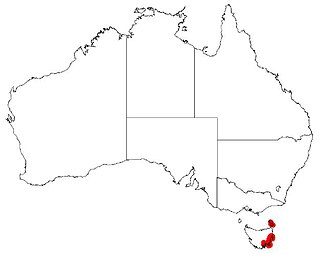
Hakea megadenia is a shrub or tree of the family Proteacea endemic to an area along the east coast of Tasmania and the Furneaux Island group off the coast of Tasmania.
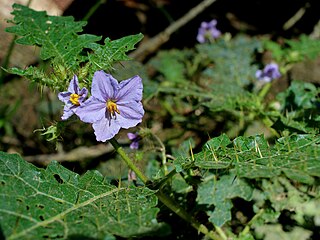
Solanum ditrichum, commonly called forest nightshade, is a low growing herbaceous perennial native to the east coast of Australia, found north of Dungog on the coast and tablelands.


















